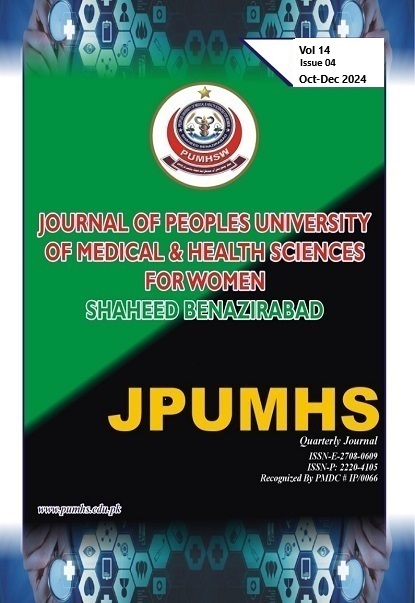PREVALENCE AND RISK FACTORS OF PEDIATRIC APPENDICITIS: A SURGICAL REVIEW AT PUMHS NAWABSHAH.
JPUMHS;2024:14:04,258-266. http://doi.org/10.46536/jpumhs/2024/14.04.586
Keywords:
Pediatric appendicitis, Risk factors, Prevalence, Appendectomy, PUMHS NawabshahAbstract
BACKGROUND: Appendicitis which describes vermiform appendix inflammation occurs
as one of the most frequent surgical emergencies found among pediatric patients on a
worldwide scale. OBJECTIVE: The aim of this study was to determine the prevalence and
identify the risk factors associated with pediatric appendicitis in children undergoing surgical
intervention at PUMHS Nawabshah. METHODOLOGY: This retrospective observational
study was conducted at the Department of Pediatric Surgery, PUMHS Nawabshah, over a
period of one year January 2024 to December 2024. Medical records of pediatric patients
diagnosed with appendicitis and who underwent appendectomy were reviewed. Data was
collected regarding patient demographics, presenting symptoms, laboratory findings, and risk
factors including age, gender, nutritional status, family history, and the presence of
comorbidities. The prevalence of appendicitis and its associated risk factors were analyzed
using descriptive statistics. RESULTS: A total of 150 pediatric patients were included in the
study, with a male-to-female ratio of 1.5:1. The prevalence of appendicitis was found to be
7.5% among pediatric patients presenting to the emergency department. The most common
presenting symptoms were abdominal pain 95%, nausea/vomiting 85%, and fever 78%.
Significant risk factors for appendicitis included age most common in children aged 6-12
years, male gender, and a family history of appendicitis. Nutritional status did not show a
significant correlation with appendicitis occurrence. Additionally, 12% of patients had a
history of recurrent abdominal pain, and 5% had a history of gastrointestinal infections.
CONCLUSION: Appendicitis remains a common surgical emergency in pediatric patients.
Early diagnosis and timely intervention are crucial for reducing morbidity. Male gender, age
between 6-12 years, and a family history of appendicitis are significant risk factors for the
condition. Further studies are recommended to evaluate the impact of nutritional status and
gastrointestinal infections on the development of appendicitis in children.
Downloads
Downloads
Published
How to Cite
Issue
Section
License

This work is licensed under a Creative Commons Attribution-NoDerivatives 4.0 International License.




